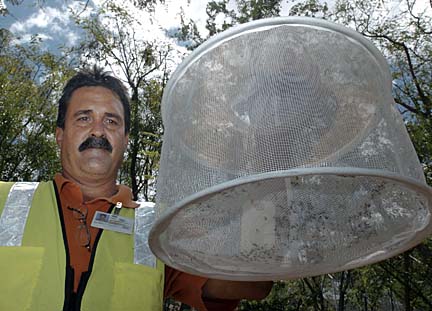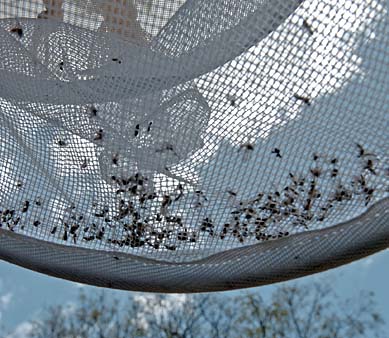
To prevent the spread of West Nile virus in Hawaii, the state has begun testing mosquitoes for traces of the potentially fatal disease. Robert Lopes of the state Vector Control Branch yesterday held one of the traps from the collection site.
State launches
mosquito-testing
campaignThe insect spreads West Nile
virus, which officials are anxious
to keep out of Hawaii
The state is stepping up its watch for the potentially deadly West Nile virus in Hawaii by checking for infected mosquitoes.
"For many years, the U.S. has treated insects like mosquitoes as just a nuisance instead of vectors (carriers) for disease," said Shokufeh Ramirez, vector-borne disease coordinator for the state Department of Health.
Dead birds needed
Testing of dead birds can help Hawaii keep out West Nile virus.Hawaii health officials want to test dead birds on all islands as a way to watch for the virus here.
The birds should be whole and recently dead. Birds missing limbs, decomposing or smelling aren't suitable.
If you think you have a bird for testing, double bag it in plastic without touching it directly, put it in a cool place and call 211 for instructions on where to take it.
People cannot catch West Nile virus from an infected bird.
For more information see www.hawaii.gov/health or www.cdc.gov.
Source: State Department of Health, federal Centers for Disease Control
With almost 9,000 reported human cases of West Nile virus and 264 deaths on the mainland last year, that's no longer the case, Ramirez said yesterday at a state demonstration at Hickam Air Force Base.
As part of state efforts to get Hawaii residents involved in keeping West Nile virus out of Hawaii, people beginning today can call 211 to get information about the disease and how to help detect it by bringing in dead birds for testing.
One of the first signs of West Nile virus in mainland states has been widespread deaths of wild birds infected through mosquitoes.
People and horses also can catch the disease from infected mosquitoes.
The disease, native to the Middle East, has swept across the continental United States to California since first being detected in New York in 1999.
So far this year, Arizona has the most confirmed human cases, 125, and two deaths. California, which had just three cases last year, has 28 this year, according to the federal Centers for Disease Control and Prevention.
Honolulu Airport and Hickam are considered major potential points of entry for West Nile virus, via infected birds or mosquitoes that come in on airplanes from the mainland, said Greg Olmsted, state Vector Control Branch manager.
Since the beginning of the year, state workers have scoured a 2 1/2-mile radius around the state's major airports and harbors, to find standing water that provides mosquito breeding grounds, Olmsted said yesterday during a media tour at Hickam.
Above are some of the mosquitoes that were collected in a 24-hour period at a Hickam Air Force Base site.
The effort is the most extensive search for a mosquito-transmitted disease the state has ever done, Olmsted said. They've also tested about 16,000 trapped mosquitoes for the virus. All were free of the disease.Should one mosquito test positive, the state plans to spray that immediate area and send out alerts statewide, Ramirez said.
"The assumption is that if one mosquito tests positive, it's not likely to be the only one out there," Ramirez said.
Of particular concern in Hawaii are endangered native forest birds, so the state Department of Land and Natural Resources and U.S. Fish & Wildlife Service also are involved in trying to keep West Nile out.
On the mainland, the virus is only a risk during the summer mosquito season. In Hawaii's mild climate, the risk would extend all year long, Olmsted said.
West Nile virus circulates between mosquitoes and birds. Infected mosquitoes can pass the virus to humans and horses. However, people cannot get West Nile virus from other infected people, horses or birds.
Most people who are infected with West Nile virus have no symptoms. About 20 percent who contract the virus have mild symptoms such as fever, headache, body aches, skin rash or swollen lymph glands.
Fewer than 1 percent of infected people develop West Nile encephalitis, a serious and sometimes fatal illness, which causes inflammation of the brain.

